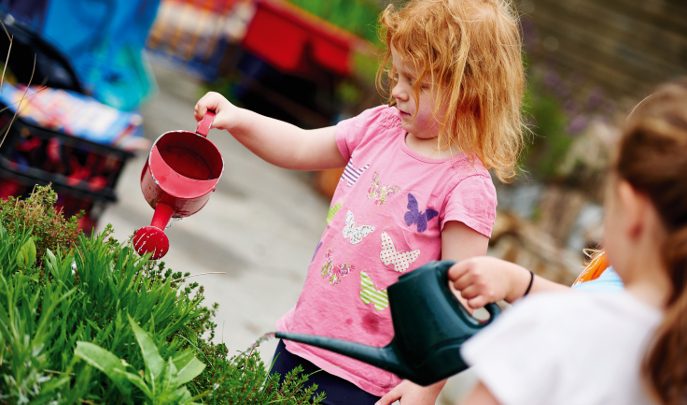Cultivating Children’s Green Fingers Is Easy – Developing Gardening Skills In EYFS

You can’t involve children in the creation of elements of their environment and then expect them not to touch or interact with it

Outdoor learning is a key part of the early years curriculum, and that includes encouraging children to grow green fingers.
Gardening, as opposed to simply playing outdoors, has many benefits, including the development of fine and gross motor skills, understanding of mathematics and science, patience and responsibility, and plenty of opportunity for open-ended questions.
Don’t delay
The best time of the year to plan what you want to do with the outdoors is during the autumn and winter. Use these less clement seasons to clear areas and see exactly what space you have, and to install any hard landscaping you may need such as raised beds or new paths.
The outside space should be usable whatever the weather, so chances are you will need to work out where you need to create shelter and shade, and what needs to be underfoot. Mobile storage is an easy way to utilise whichever area is most appropriate.
Have a look at the current permanent features such as trees, fences, hedges, canopies and buildings. Can you use them? Do they need repairing or replacing? Would you be better off without them and is removing them feasible?
If you just need a good tidy up, power wash and replant but simply don’t have the time, see if you can get a working party of parents and helpers from the community together – the promise of tea and cake can go a long way!
When the audit is done it’s time to let your imagination run wild. There is no reason why the broad-brush planning that goes on inside your setting cannot be extended outdoors too.
Experience has shown me that any topic, theme or learning objective can be adapted and enhanced by taking it outside (courgette leaves make amazing hiding places for dinosaurs!). The tricky part, especially for those less green-fingered, is making gardening part of that adventure, so here is a list of things to consider. Tackle as many or as few as you feel comfortable with to add an extra dimension to your setting.
Planting edibles
These are pretty self-explanatory but you need to plan ahead. If your setting is a preschool that will be closed for the long summer holidays, it’s best not to plant crops such as strawberries, cucumbers or tomatoes that are harvested then. Instead choose potatoes or other roots or brassicas that will keep until autumn, or lettuces and radishes that are quick to mature and can be picked in June. It is also worth noting that if you plan to garden in containers, somebody needs to water them during the holidays.
Growing sunflowers
Great for learning about growth and decay as well as mathematics, sunflowers start as a small seed and finish up as a towering stem with a big flower whose seeds will feed the birds in the winter. If you plan to grow the tallest ones they will benefit from being grown next to a (sunny) fence, so that they can be tied in and supported. It is also nice to put them near to a climbing frame so little ones can follow the flower heads as they get taller.
Decorating trees
Try creating a topic tree – this can be a real, small one or simply a group of artificial branches; the point is that it can be decorated with absolutely anything. Again, take your indoor planning outside and use the craft table to make trinkets that tie in with your current learning objectives. Obvious themes are Christmas or the seasons, but everything from minibeasts to jungle animals works well.
Painting pebbles
Take literacy, numeracy and art outside by painting pebbles with children’s names, numerals, spots, shapes, minibeasts or simply a rainbow of colours. Large plant pots or saucers are great for sorting them too.
Sensory stimulation
A sensory theme to a garden is a good starting place when you are planning your space as it means you will get a bit of everything. You may want to start by concentrating on just one of the senses and add more as the garden develops, or go for all of them in a sensory corner. Bright colours from flowers or ornaments can sit beside aromatic herbs such as thyme, rosemary, mint and lavender. The latter are robust and hardy, will not mind being bruised and will complement seasonal fruit and vegetables. Mix in some different textures, some spiky tufty plants, soft wavy grasses and polished pebbles. Sound can come from tall, swishy-swashy bamboo or, if you are lucky, a bubble fountain or other feature with no standing water.
Attracting wildlife
While worms, bugs and spiders are not everyone’s cup of tea they are all part of a garden and it is well worth keeping an area relatively undisturbed with logs and piles of leaves in it to see what moves in. At the setting I work in we are fortunate to have access to a woodland area which the children love to explore, turning over logs to see what lies beneath. We also keep bird feeders topped up and can watch the visitors (birds and squirrels) from inside whatever the weather.
Demonstrating change
Summer is a time for instant gardening – planting a few tubs with bright annuals are a welcome boost, but things like spring bulbs need to be planted in autumn so planning is essential. Again, this is something that every child can easily get involved with and it is a useful way to demonstrate ‘change over time’ as once they get going growth is rapid.
Finally, accept that you cannot be precious about anything in your garden! You can’t involve children in the creation of elements of their environment and then expect them not to touch or interact with it. Give them the opportunity to learn, explore and nurture in a way that complements what they do indoors and you will have a happy setting!
ARE YOU READY?
Four tips to ensure you’re prepared to garden successfully.
• Think about investing in a set of overtrousers and jackets so that you can access all parts of the garden whatever the weather. Gardening gloves can be cumbersome but they are useful for those children for whom dirty hands are a barrier to learning.
• Don’t forget to include some kind of seating area; children struggle to observe change in the environment unless they stop still for long enough, and everybody loves a den!
• Look out for poisonous or irritant plants; a quick internet search will give you a lot of information about what to avoid.
• Little is constant in a garden, it evolves as plants grow and decay with the seasons. It is useful to keep a perpetual diary to make a note of what has been particularly successful or not, ideas for next year and to remind yourself to do seasonal tasks.
Samantha Tennant is a nursery assistant at a village preschool in Cheshire.








